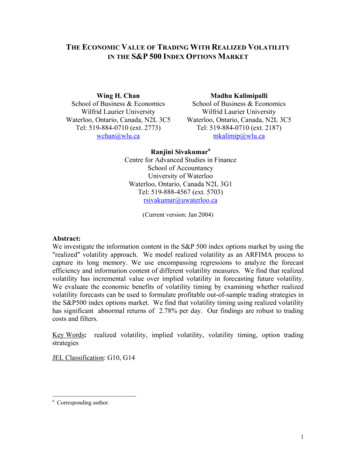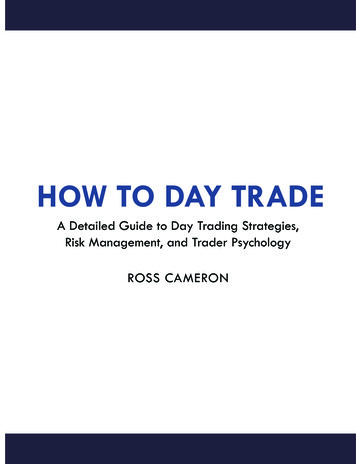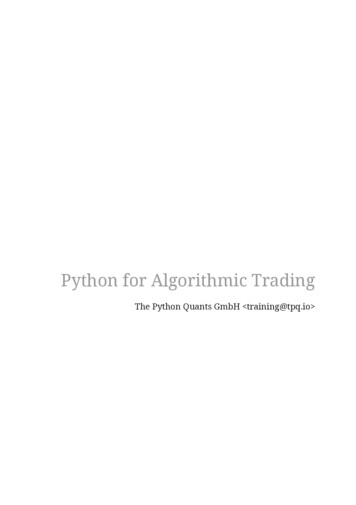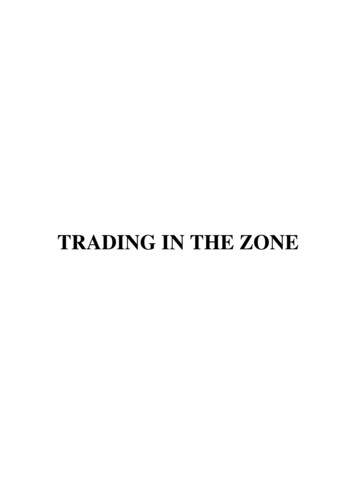
Transcription
THE ECONOMIC VALUE OF TRADING WITH REALIZED VOLATILITYIN THE S&P 500 INDEX OPTIONS MARKETWing H. ChanSchool of Business & EconomicsWilfrid Laurier UniversityWaterloo, Ontario, Canada, N2L 3C5Tel: 519-884-0710 (ext. 2773)wchan@wlu.caMadhu KalimipalliSchool of Business & EconomicsWilfrid Laurier UniversityWaterloo, Ontario, Canada, N2L 3C5Tel: 519-884-0710 (ext. 2187)mkalimip@wlu.caRanjini SivakumaraCentre for Advanced Studies in FinanceSchool of AccountancyUniversity of WaterlooWaterloo, Ontario, Canada N2L 3G1Tel: 519-888-4567 (ext. 5703)rsivakumar@uwaterloo.ca(Current version: Jan 2004)Abstract:We investigate the information content in the S&P 500 index options market by using the"realized" volatility approach. We model realized volatility as an ARFIMA process tocapture its long memory. We use encompassing regressions to analyze the forecastefficiency and information content of different volatility measures. We find that realizedvolatility has incremental value over implied volatility in forecasting future volatility.We evaluate the economic benefits of volatility timing by examining whether realizedvolatility forecasts can be used to formulate profitable out-of-sample trading strategies inthe S&P500 index options market. We find that volatility timing using realized volatilityhas significant abnormal returns of 2.78% per day. Our findings are robust to tradingcosts and filters.Key Words:strategiesrealized volatility, implied volatility, volatility timing, option tradingJEL Classification: G10, G14aCorresponding author.1
THE ECONOMIC VALUE OF TRADING WITH REALIZED VOLATILITYIN THE S&P 500 INDEX OPTIONS MARKET1. IntroductionRecent studies on volatility modeling have focused on estimating volatility fromhigh-frequency data. In this approach, volatility is estimated by summing the squares ofintra-day returns over very short intervals. This measure is called realized volatility. Theidea was originally proposed by Merton (1980), who showed that precise estimates ofvolatility can be obtained over fixed time intervals as the sampling interval approacheszero. In the limit, unobservable volatility becomes observable.Recent work using realized volatility includes Andersen, Bollerslev, Diebold andLabys (2001b). These authors argue that this estimation is model-free and theoreticallyfree from measurement error. Andersen, Bollerslev, Diebold and Ebens (2001a) use thisapproach in their study of the Dow Jones Industrial Average and find that realizedvolatility is lognormally distributed. They also find that daily returns standardized byrealized volatility are approximately normal. Finally, they show that realized volatility isbest described by a long-memory process such as a fractionally integrated autoregressiveprocess. These findings are consistent across asset classes (for exchange rates, seeAndersen et al. 2001b and for the Dow Jones Index, see Ebens, 1999). In a recent paper,Andersen, Bollerslev, Diebold and Labys (2003) show that the volatility forecasts usingrealized volatility dominate the GARCH models.Overall, the realized volatilityapproach has much to recommend it based on its theoretical soundness, ease inimplementation, nice estimation properties, and easy extension to a multivariate setting.Bai, Russell and Tiao (2002) present a dissenting note. They contend that thesampling interval cannot practically go to zero. More importantly, at high frequency they1
argue that the geometric Brownian motion assumption does not hold. They examineintra-day exchange rate data and find that the data are characterized by clustering,kurtosis and long memory. They conclude that these features reduce the precision of thevolatility estimates using realized volatility. They point out that since the kurtosis andpersistence increase with sampling frequency, choosing an optimal frequency is critical.Consistent with these findings, Pong, Shackleton, Taylor and Xu (2002) show that out-ofsample tests are sensitive to the sampling frequency used to construct the realizedvolatility.Given these contradictions, the interesting question is whether the realizedvolatility approach would be useful in financial decisions such as investmentmanagement, risk management, asset pricing etc.Blair, Poon, and Taylor (2001)examine short term volatility forecasting using the S&P 100 index options and find thatimplied volatility (IV) is more informative than realized volatility about future volatility.Poteshman (2000) finds that approximately half the forecasting bias in the S&P500 indexoptions market is eliminated by constructing measures of realized volatility from fiveminute observations on S&P 500 futures rather than the index. More importantly hefinds that the bias is nearly eliminated when the Heston option-pricing model is usedinstead of the Black-Scholes option-pricing model. In a recent study, Fleming, Kirby andOstdiek (2003) find that volatility timing using realized volatility has economic valueboth for short and long horizons when trading stocks.In this paper, we undertake a comprehensive examination of the economic valueof realized volatility in index option markets. We address the following issues:2
Does the historical realized volatility have incremental value to the Black andScholes implied volatility in forecasting future realized volatility in indexmarkets? Can realized volatility be used to trade profitably in option markets?We answer the first question by examining if realized volatility has incrementalvalue to the Black-Scholes implied volatility in forecasting future realized volatility inindex markets by studying at-the-money (ATM) S&P 500 index options with shortmaturity.We model realized volatility as a long-memory process.We useencompassing regressions to analyze the forecast efficiency and information content ofdifferent volatility measures.To answer the second question, we evaluate the economic benefits of volatilitytiming to an options trading strategy by examining whether realized volatility forecastscan be used to formulate profitable out-of-sample trading strategies in the S&P500 indexoptions market. We use the framework proposed by Noh, Engle, and Kane (1994) toestimate the profits from the options trading strategies. Noh et al. (1994) show thatsimple GARCH models outperform implied volatility models for investors trading inATM straddles, after accounting for transaction costs. We find that volatility timingusing realized volatility has significant abnormal returns of 2.78% per day. Our findingsare robust to trading costs and filters.Following prior research, we adopt a research design that minimizes potentialmeasurement errors.We use high frequency index returns and a long-memoryspecification to obtain a more accurate estimate of realized volatility. We estimate theimplied volatility using the Whaley (1982) approach by using all ATM options around a3
ten-minute window around the stock market close.This procedure minimize theproblems related to bid-ask bounce, non-continuous option prices, infrequent trading andnon-simultaneity of prices of options and the underlying index. To avoid the telescopingerror problem that arises in overlapping data, we perform the tests using the generalizedmethod of moments (GMM) approach (Fleming, 1998). We also perform sensitivitytests; first we use instrumental variables and second we use forecasts for fixed horizons.Finally, since the research question is a joint test of market efficiency as well asaccuracy of the forecasting procedure, the option pricing model used is important.Bakshi, Cao and Chen (1997) find that for ATM options, the Black Scholes model doesas well as stochastic volatility based pricing models. Hence, we use the Black-Scholesmodel (adjusted for dividends) to price the S&P 500 index options, which are Europeanin nature.We find that realized volatility has incremental value over implied volatility inforecasting future volatility.We find that option trading strategies using realizedvolatility are profitable. The overall value of volatility timing in these strategies is2.78.% per day net of transaction costs. Our findings are robust to trading costs, andfilters.The remainder of the paper is organized as follows. Section 2 provides themotivation and research design. Section 3 describes the data. Section 4 discusses theresults from the encompassing regressions and presents the results of our sensitivity tests.Section 5 presents the results from the option trading strategies. Section 6 concludes.2. Research Design4
Next we describe the research methodology that we adopt to explore the researchquestions.B. Does realized volatility have incremental value to the Black-Scholes impliedvolatility in forecasting future realized volatility in index markets?We follow the approach adopted by Fleming (1998). The paper develops a relationbetween the implied volatility and the true time-varying volatility as follows. Considerthe Hull and White (1987) model where the asset price and volatility are uncorrelated andthe volatility risk premium is zero. At time t, the value of an option expiring at T isf t E [BS (σ t ;T ) Φ t ] ,(1)which is the expected Black-Scholes value evaluated at the average instantaneousvolatility over the option’s life, σ t ;T 1 T 2 σ x dx , given the information set Φ t .T 1 tFor short-maturity ATM options,E [BS (σ t ;T ) Φ t ] BS (E [σ t ;T Φ t ])(2)Hence,f t BS (E [σ t ;T Φ t ])(3) 1For an exact approximation, the implied volatility is σ tIV;T BS ( f t )Hence,σ tIV;T E [σ t ;T Φ t ](4)This implies that IV should represent an unbiased forecast of average volatility over thelife of the option and its forecast error should be orthogonal to information at time t.5
Following prior research (Christen and Prabhala, 1998 and Jiang and Tian, 2003),we use both univariate and encompassing regression to analyze the unbiasedness andinformation content of the volatility forecasts. The forecasts are used from a historicalvolatility (HV) model (20-day moving average of realized volatility), a long-memorymodel (ARFIMA), a GARCH(1,1) model and an ARFIMA (leverage) model. To avoidthe telescoping error problem that arises in overlapping data, we perform the tests usingthe generalized method of moments (GMM) approach (Fleming, 1998).Univariate regression:We use the following specifications:σ trealized a b1σ tIV,T,T ε 1t ,T ,(5a)σ trealized a b1σ tHV,T,T ε 2t ,T ,(5b)σ trealized a b1σ tARFIMA ε 3t ,T ,,T,T(5c)σ trealized a b1σ tGARCH ε 4t ,T ,,T,T(5d)LEVσ trealized a b1σ tARFIMA ε 5t ,T ,,T,T(5e)Information content hypothesis:In the above specifications if the volatility forecast has no information regardingfuture realized volatility, the testable hypothesis is H0: b1 0.Unbiasedness hypothesis:If the volatility forecast is an unbiased estimate of future realized volatility, thetestable hypothesis is H0: a 0 and b1 1.Encompassing regressionWe use the following specifications:6
FVσ trealized a b1σ tIV,T,T b2σ t ,T ε t ,T ,(5g)where σ tFV;T is forecasted volatility and includes one of the following models: thehistorical volatility model, the ARFIMA model, a GARCH(1,1) model and an ARFIMA(leverage) model.Information content hypothesis:If the information content in the forecasted volatility model is subsumed in theimplied volatility forecast, the testable hypothesis is H0: b2 0.Unbiasedness hypothesis:If the implied volatility forecast is an unbiased estimate of future realizedvolatility, the testable hypothesis is H0: b1 1 and b2 0.B.Can realized volatility be used to formulate profitable out-of-sample tradingstrategies in the options market?We use realized volatility forecasts to trade in ATM delta-neutral straddles. All ourtrading strategies are based on out-of-sample forecasts. We provide the details of thestraddle trading strategy in Appendix 1. We apply the bid-ask spread and transaction costfilters for all the trades, as described in steps 6 and 7 of Appendix 1. As the tradingstrategies are delta neutral, the returns do not need risk adjustment for minor stock pricemovements and represent abnormal returns. We compare the profits net of transactioncosts and bid-ask spreads.7
3. Data and Summary StatisticsWe use high frequency tick-by-tick S & P 500 data for the 7-year period: 01/1996 to12/ 2002 for a total of 1,738 trading days. The intraday realized volatility for day t isobtained by the sum of squared returns at finely sampled intervals over a day.We choose the S&P 500 index ATM options because they are widely traded. TheSPX intra-day option data is obtained from the Chicago Mercantile Exchange for thesame sample period. We assume that the S&P 500 daily dividend yield interpolated tomatch the maturity of the option contract is a reasonable proxy for the dividends paid oneach option contract. We use the three-month Treasury-bill rate as a proxy for the riskfree rate in the Black-Scholes valuation model.Options with moneyness (strike price/index level) in the range 0.97 to 1.03 aredeemed as ATM options. We exclude options with maturities below 15 days and above180 days. We only retain options with daily volumes greater than 100. For a givenexercise price and maturity, options that have both put and call prices are retained.Options that violate the put-call parity relationship are excluded. Based on these criteria,our sample consists of 1,027 call-put options pairs on 1,738 trading days.Figure 1 shows the volatility signature plot for realized volatility obtained over arange of sampling intervals. From the graph, we observe that the realized volatilityshows no trend at and after the 15-minute intervals. Hence, we use the realized volatilityobtained by the sum of squared returns at 15-minute intervals over a day. The summarystatistics for the realized volatility and implied volatility are given in Table 1. Therealized volatility specified as standard deviation and variance are positively skewed andleptokurtic. However the logarithmic standard deviation is approximately Gaussian. The8
autocorrelations for the FIGARCH process die out quickly as shown in Figure 2. Thisimplies that realized volatility has a long memory that is captured by a fractionallyintegrated process (ARFIMA).Figure 3 suggests the asymmetric volatility effects are present in the data. In Figure 4,we see that the ARFIMA process is an improvement over the GARCH process since itcaptures the long memory characteristic of realized volatility. We observe that theARFIMA dies out quickly after a shock and does not persist as GARCH process. Therealized volatility process unlike GARCH seems to bevery sensitive to shocks overtime and shows periods of very high volatility too often. Figure 5 plots the impliedvolatilities from the options market. The IVS from calls and puts look similar and broadlyshare the features of the volatilities from time-series models.4. Results4.1 Unbiasedness tests:The results for the unbiasedness tests for S&P500 call options are provided inTable 2. The models are estimated using the GMM approach proposed by Fleming(1998). In Panel A, we use the standard deviation as the specification for the realizedvolatility. Models 1 to 5 are the univariate specifications. The null hypothesis that thevolatility forecast is an unbiased forecast of future realized volatility is rejected for allfive models by the Wald test measure. The R2 measure indicates that the ARFIMALeverage forecast is the most informative volatility forecast. These results hold in panelsB and C as well where realized volatility is specified as variance and logarithmic standarddeviation.9
Models 6 to 9 are the encompassing regression results. The results suggest thatimplied volatility does not subsume the information contained in the other volatilityforecast measures. Notice that the coefficient for the implied volatility forecast is lowerin the encompassing regression compared to the univariate regression. The R2 for theencompassing regressions are larger than the univariate regressions. Furthermore, the R2for the ARFIMA-Lev forecast is the largest indicating that the forecasts have the highestadditional information content. Table 3 presents the results for put options and all theabove results hold as well for puts. The findings from the univariate specifications andencompassing regressions are consistent with Christensen and Prabhala (1998) and Jiangand Tian (2002).4.2 Robustness Tests:Instrumental variables:We next use lagged implied volatility as an instrumental variable in both theunivariate and encompassing regressions.The results for S&P500 call options arepresented in Table 4. While, the univariate results are similar to our earlier findings, theresults from the encompassing regressions are interesting. We find that implied volatilitydoes not subsume the information contained in the ARFIMA and ARFIMA-Lev forecastmeasures, but the historical volatility and GARCH volatility have no additionalinformation content.10
Constant horizons:The analysis so far has pooled data for options with different horizons. In Figure6, we plot the regression coefficients from equation 6a against the maturity of options.The plot shows that the coefficients are sensitive in short horizons (one month).Consequently in Table 5, we present the results for forecasting horizons of a day in PanelA and for 30 days in Panel B. The results for both forecasting horizons are similar to ourearlier findings. The R2 for the shorter horizon is larger compared to the longer horizon.The results suggest that implied volatility is a biased predictor of realizedvolatility. We also find that there is incremental information in out-of-sample forecastsof realized volatility indicating that IV does not subsume all information about realizedvolatility.Next, we investigate if the incremental information in realized volatilityforecasts can be used profitably to trade in options.5. Option trading strategiesTable 6 presents the results for delta-neutral straddles based on realized volatilityforecasts based on the procedure described in Appendix 1. Panel A shows that theaverage moneyness (X/S) is 1.013 while the average maturity is 22.21 days. The modelprice is lower compared to the option prices implying that options are over priced.Panel B in Table 5 gives us the number of buys and sells of the delta-neutralstraddles using a bid-ask filter ( 0.50) for stock price changes. We find that the totaltrades are lower than that in Panel A because of attrition due to the filter rule. Straddlesare sold more often because they are over-priced according to all the models. We findthat in general straddles are sold in 75% of the trades.11
Panel C presents percentage returns on trading in the delta-neutral straddles usinga bid-ask filter and 0.5% transaction costs. We find that the trading strategy is profitablewith a significant daily return of 2.78% after transaction costs.6. ConclusionsWe examine the information content in the S&P 500 index options market byusing the "realized" volatility approach. We model realized volatility as an ARFIMAprocess to capture its long memory. We adopt a research design that minimizes potentialmeasurement errors. We find that realized volatility has incremental value over impliedvolatility in forecasting future volatility. These findings are robust to sensitivity tests.We evaluate the economic benefits of volatility timing by examining whetherrealized volatility forecasts can be used to formulate profitable out-of-sample tradingstrategies in the S&P500 index options market. We find that volatility timing usingrealized volatility has significant abnormal returns of 2.78% per day. Our findings arerobust to trading costs and filters.Additional research questions that we intend to examine include examiningwhether banks or financial institutions limit their risks using realized volatility forecastsand whether option prices based on realized volatility have lower pricing errors in meansquared error (MSE) sense compared to other volatility models.12
Appendix 1Trading strategy based on straddles1.Estimate the realized volatility on day t and obtain the forecast of future volatility for each dayuntil the maturity of the option. Obtain the arithmetic average of such future volatility forecastsfor each model on day t. Use this measure as a volatility proxy to price an option on day t usingthe Black-Scholes pricing formula.2. From the in-sample daily volatility forecast for day t from step 1, obtain the delta-neutral (DN)straddle for that day. In particular, given that delta of the call and put are respectively N(d1) andN(d1) –1, the strike price x that gives a delta -neutral straddle on day t can be solved as :N ( d1 ) N ( d1 ) 1 0;x S2 r σ f 2 Te where S , r f ,σ and T refer to the spot price, risk free rate, volatility and time to maturityrespectively. On day t, determine that traded straddle combination whose exercise price is closestto the x described above. Use only ATM calls and puts in this exercise. Price the ATM DNstraddle using the Black-Scholes option-pricing model.3. Next, buy or sell the ATM DN straddle on day t depending on whether the straddle model price isunder or over-priced relative to the closing market straddle price on that day. When the straddle issold, the agent invests the proceeds in a risk-free asset.4.The rate of return is calculated as follows:Return on buying a straddle Return on selling a straddle C t Pt C t 1 Pt 1C t 1 Pt 1 ( C t Pt C t 1 Pt 1 ) rfC t 1 Pt 1where Ct and Pt refer to the call and puts prices of S & P 500 index options.5.Implement steps 1-4 for each trading day in the sample.6.For all the trades, apply the bid-ask spread filter (that accounts for the bid-ask bounce) as in Nohet al. (1994). The agent trades only when the absolute price difference between the model andmarket price is expected to exceed 0.50.7.Further, apply 0.5% trading costs, while calculating the net returns for the strategies. The 0.5%trading cost corresponds to a trader with 48,000 investment who pays a commission amountingto 120 0.0025 of the dollar amount as per a standard commission schedule (see Hull (2000) p.160).13
References:Andersen, T. G., T. Bollerslev, F. X. Diebold, and H. Ebens, 2001a. The distribution ofrealized stock return volatility, Journal of Financial Economics 61, 43-76.Andersen, T. G., T. Bollerslev, F. X. Diebold, and P. Labys, 2001b. The distribution ofrealized exchange rate volatility, Journal of the American Statistical Association96, 42-55.Andersen, T. G., T. Bollerslev, F. X. Diebold, and P. Labys, 2003. Modeling andforecasting realized volatility, Econometrica 71, 579-625.Bai, X., J. R. Russell, and G. Tiao, 2002, Beyond Merton’s Utopia I: Effects ofdependence and non-normality on variance estimates using high-frequency data,Working paper, Chicago Graduate School of Business.Bakshi, G., Cao, C., Chen Z., 1997, Empirical performance of alternative option pricingmodels, Journal of Finance 52, 2003-2049.Bandi, F. M., and B. Perron, A fundamentally different interpretation of the relationbetween implied and realized volatility, Working paper, FENBarndorff-Nielsen O. E.; and N. Shephard, 2002, Econometric analysis of realizedvolatility and its use in estimating stochastic volatility models, Journal of theRoyal Statistical Society B 64, 253-280.Blair, B. J., S. Poon, and S. J. Taylor, 2001, Forecasting S&P100 volatility: Theincremental information content of implied volatilities and high-frequency indexreturns, Journal of Econometrics 105, 5-26.Christensen, B.J. and N.R. Prabhala, 1998, The relation between implied and realizedvolatility, Journal of Financial Economics 50, 125-150.Corsi, F., G. Zumbach, U. Muller, and M. Dacorogna, 2001, Consistent high-precisionvolatility from high-frequency data, Working paper, FENEbens, 1999, Realized stock index volatility, Working paper, John Hopkins University.Fleming, J, 1998, The quality of Market volatility forecasts implied by S & P 100 indexoption prices, Journal of Empirical Finance, 5,317-345.Fleming, J., C. Kirby, B. Ostdiek, 2003, The economic value of volatility timing using“realized” volatility, Journal of Financial Economics 67, 473-509.Hull, J., and A. White, 1987, The pricing of options on assets with stochastic volatilities,Journal of Finance 42, 281-300.14
Jiang, G.J. and Y.S. Tian, 2003, Model free implied volatility and it information content,Working paper, York University.Whaley, R.E ,1982, Valuation of American call options on dividend paying stocks:Empirical tests, Journal of Financial Economics 10, 29-58.Martens, M., and J. Zein, 2002, Predicting financial volatility: High-frequency timeseries forecasts vis-à-vis implied volatility, Working paper, FENMerton, R. C., 1980, On estimating the expected return on the market: an exploratoryinvestigation, Journal of Financial Economics 8, 323-361.Meddahi, N., 2002, A theoretical comparison between integrated and realizedvolatility,Journal of Applied Econometrics 17, 479-508.Neely, C. J., 2002, Forecasting foreign exchange volatility: Is implied volatility the bestwe can do? Working paper, Federal Reserve Bank of St. LouisNoh, J., R. Engle, and A. Kane, 1994, Forecasting volatility and option prices of the S&Pindex, Journal of Derivatives, Fall, 17-30.Pong, S., M. B. Shackleton, S. J. Taylor and X. Xu, 2002, Forecasting sterling/dollarvolatility: A comparison of implied volatilities and AR(FI)MA models, Workingpaper, FENPoteshman, A. M., 2000, Forecasting future volatility from option prices, Working paper,FEN15
Table 1Summary 90.45680.26950.3519IV call0.21450.05481.14762.7173IV put0.19850.05691.17182.024816
Table 2Panel A: Realized Volatility is specified as standard deviationUnbiasedness Tests of S&P 500 data (Call Options)M1M2M3M4M5M6M7M8M9log(σit 61-0.3568-0.2589(20.6116) (29.4124) (17.5940) (40.6266) (16.4826) (20.0003) (14.4317) (19.8731) ARFIMA-LEV2Adj. .630.2590156.070.3327200.30The models are estimated using the GMM approached proposed by Fleming (1998). The encompassing regression is def ined byσt,T realized a b1σt,T IV b2σt,T FV εt,T . σt,T FV is f orecasted volatility that can be historical volatility (HV), autoregressive f ractionallyintegrated moving average (ARFIMA) model, generalized autoregressive heteroskedasticity (GARCH) model, and ARFIMA modelw ith leverage ef f ect (ARFIMA-LEV).CS2 is an asymptotic Wald test of the joint null that α 0 and β 1 f or a particular f orecast. β isref erring to the coef f icient associated w ith the implied volatility. * The Wald test is perf ormed f or the corresponding f orecast. HV is20-day moving average of the realized volatility. The sample is f rom January 2, 1996 to December 31, 2002.Panel B: Realized Volatility is specified as varianceUnbiased tests of S& P 500 data (call EV20.0166(5.5199)(6.1472)HVAdj. RCS he models are estimated using the GMM approached proposed by Fleming (1998). The encompassing regression is def ined byσt,T realized a b1σt,T IV b2σt,T FV εt,T . σt,T FV is f orecasted volatility that can be historical volatility (HV), autoregressive f ractionallyintegrated moving average (ARFIMA) model, generalized autoregressive heteroskedasticity (GARCH) model, and ARFIMA modelw ith leverage ef f ect (ARFIMA-LEV).CS2 is an asymptotic Wald test of the joint null that α 0 and β 1 f or a particular f orecast. β isref erring to the coef f icient associated w ith the implied volatility. * The Wald test is perf ormed f or the corresponding f orecast. HV is20-day moving average of the realized volatility. The sample is f rom January 2, 1996 to December 31, 2002.17
Panel C: Realized Volatility is specified as natural log of standard deviationUnbiasedness Tests of S&P 500 data (Call EV20.0813(3.5718)(4.2958)HVAdj. RCS e models are estimated using the GMM approached proposed by Fleming (1998). The encompassing regression is def ined byσt,T realized a b1σt,T IV b2σt,T FV εt,T . σt,T FV is f orecasted volatility that can be historical volatility (HV), autoregressive f ractionallyintegrated moving average (ARFIMA) model, generalized autoregressive heteroskedasticity (GARCH) model, and ARFIMA modelw ith leverage ef f ect (ARFIMA-LEV).CS2 is an asymptotic Wald test of the joint null that α 0 and β 1 f or a particular f orecast. β isref erring to the coef f icient associated w ith the implied volatility. * The Wald test is perf ormed f or the corresponding f orecast. HV is20-day moving average of the realized volatility. The sample is f rom January 2, 1996 to Decemb
forecasting future volatility. We find that option trading strategies using realized volatility are profitable. The overall value of volatility timing in these strategies is 2.78.% per day net of transaction costs. Our findings are robust to trading costs, and filters. The remainder of










